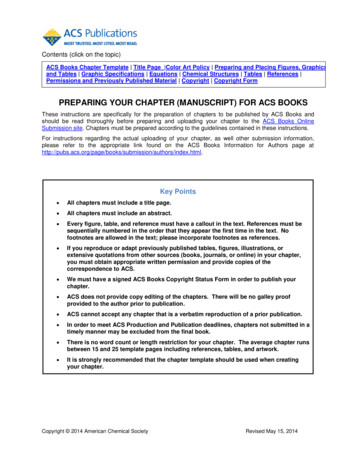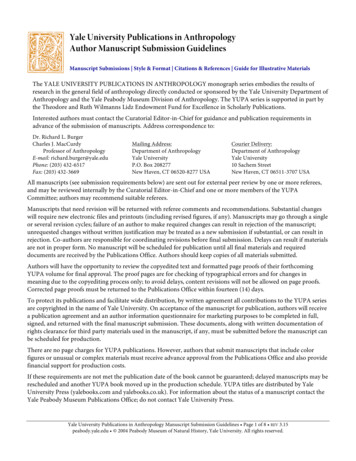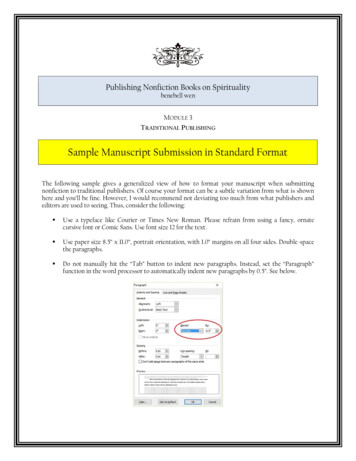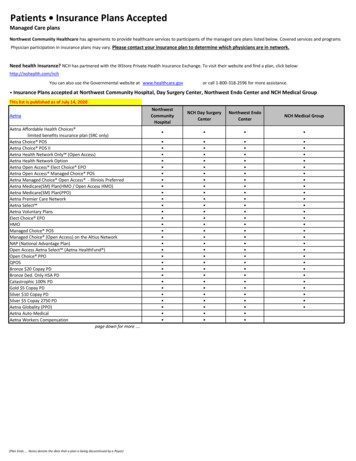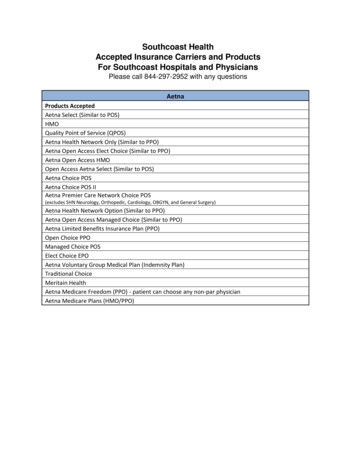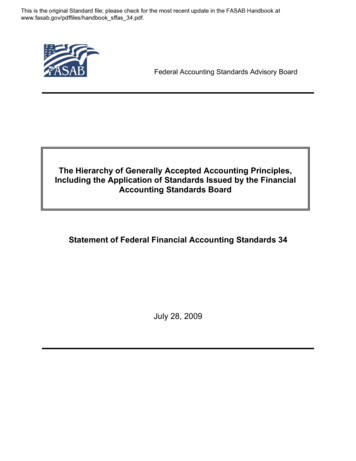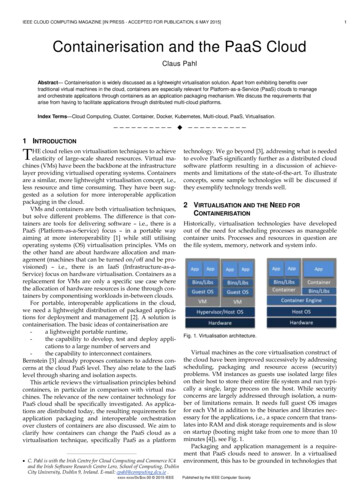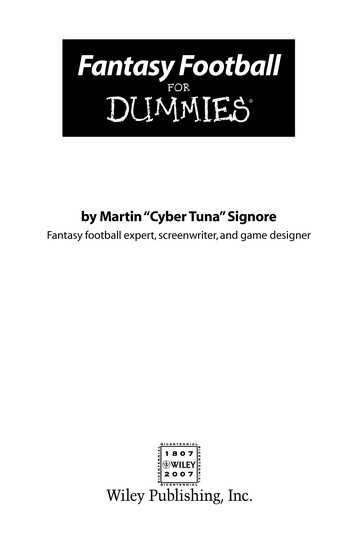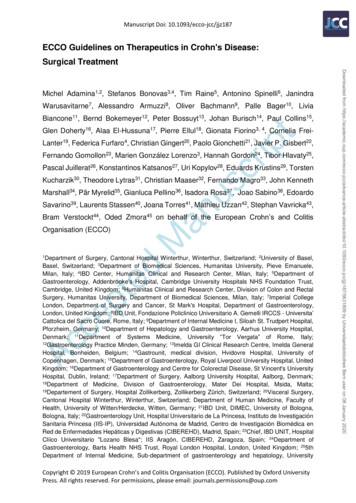
Transcription
Manuscript Doi: 10.1093/ecco-jcc/jjz187ECCO Guidelines on Therapeutics in Crohn's Disease:Surgical TreatmentWarusavitarne7, Alessandro Armuzzi8, Oliver Bachmann9, Palle Bager10, LiviaBiancone11, Bernd Bokemeyer12, Peter Bossuyt13, Johan Burisch14, Paul Collins15,tGlen Doherty16, Alaa El-Hussuna17, Pierre Ellul18, Gionata Fiorino3, 4, Cornelia Frei-cripLanter19, Federica Furfaro4, Christian Gingert20, Paolo Gionchetti21, Javier P. Gisbert22,Fernando Gomollon23, Marien González Lorenzo3, Hannah Gordon24, Tibor Hlavaty25,Pascal Juillerat26, Konstantinos Katsanos27, Uri Kopylov28, Eduards Krustins29, TorstenusKucharzik30, Theodore Lytras31, Christian Maaser32, Fernando Magro33, John KennethMarshall34, Pär Myrelid35, Gianluca Pellino36, Isadora Rosa37, Joao Sabino38, EdoardoanSavarino39, Laurents Stassen40, Joana Torres41, Mathieu Uzzan42, Stephan Vavricka43,Bram Verstockt44, Oded Zmora45 on behalf of the European Crohn’s and ColitisMOrganisation (ECCO)of Surgery, Cantonal Hospital Winterthur, Winterthur, Switzerland; 2University of Basel,Basel, Switzerland; 3Department of Biomedical Sciences, Humanitas University, Pieve Emanuele,Milan, Italy; 4IBD Center, Humanitas Clinical and Research Center, Milan, Italy; 5Department ofGastroenterology, Addenbrooke's Hospital, Cambridge University Hospitals NHS Foundation Trust,Cambridge, United Kingdom; 6Humanitas Clinical and Research Center, Division of Colon and RectalSurgery, Humanitas University, Department of Biomedical Sciences, Milan, Italy; 7Imperial CollegeLondon, Department of Surgery and Cancer, St Mark's Hospital, Department of Gastroenterology,London, United Kingdom; 8IBD Unit, Fondazione Policlinico Universitario A. Gemelli IRCCS - Universita’Cattolica del Sacro Cuore, Rome, Italy; 9Department of Internal Medicine I, Siloah St. Trudpert Hospital,Pforzheim, Germany; 10Department of Hepatology and Gastroenterology, Aarhus University Hospital,Denmark; 11Department of Systems Medicine, University “Tor Vergata” of Rome, Italy;12Gastroenterology Practice Minden, Germany; 13Imelda GI Clinical Research Centre, Imelda GeneralHospital, Bonheiden, Belgium; 14Gastrounit, medical division, Hvidovre Hospital, University ofCopenhagen, Denmark; 15Department of Gastroenterology, Royal Liverpool University Hospital, UnitedKingdom; 16Department of Gastroenterology and Centre for Colorectal Disease, St Vincent's UniversityHospital, Dublin, Ireland; 17Department of Surgery, Aalborg University Hospital, Aalborg, Denmark;18Department of Medicine, Division of Gastroenterology, Mater Dei Hospital, Msida, Malta;19Departement of Surgery, Hospital Zollikerberg, Zollikerberg Zürich, Switzerland; 20Visceral Surgery,Cantonal Hospital Winterthur, Winterthur, Switzerland; Department of Human Medicine, Faculty ofHealth, University of Witten/Herdecke, Witten, Germany; 21IBD Unit, DIMEC, University of Bologna,Bologna, Italy; 22Gastroenterology Unit, Hospital Universitario de La Princesa, Instituto de InvestigaciónSanitaria Princesa (IIS-IP), Universidad Autónoma de Madrid, Centro de Investigación Biomédica enRed de Enfermedades Hepáticas y Digestivas (CIBEREHD), Madrid, Spain; 23Chief, IBD UNIT, HospitalClíico Universitario "Lozano Blesa"; IIS Aragón, CIBEREHD, Zaragoza, Spain; 24Department ofGastroenterology, Barts Health NHS Trust, Royal London Hospital, London, United Kingdom; 255thDepartment of Internal Medicine, Sub-department of gastroenterology and hepatology, UniversityAccepted1DepartmentCopyright 2019 European Crohn’s and Colitis Organisation (ECCO). Published by Oxford UniversityPress. All rights reserved. For permissions, please email: journals.permissions@oup.comDownloaded from abstract/doi/10.1093/ecco-jcc/jjz187/5631809 by Universitaetsbibliothek Bern user on 08 January 2020Michel Adamina1,2, Stefanos Bonovas3,4, Tim Raine5, Antonino Spinelli6, Janindra
Manuscript Doi: ed from abstract/doi/10.1093/ecco-jcc/jjz187/5631809 by Universitaetsbibliothek Bern user on 08 January 2020hospital Bratislava and Faculty of Medicine, Comenius University Bratislava, Slovakia;26Gastroenterology, Clinic for Visceral Surgery and Medicine, Inselspital, University Hospital of Bern,Bern, Switzerland; 27Department of Gastroenterology and Hepatology, Division of Internal Medicine,University and Medical School of Ioannina, Ioannina, Greece; 28 Department of Gastroenterology, TelHaShomer Sheba Medical Center, Ramat Gan, and Sackler Medical School, Tel Aviv, Israel;29Department of Gastroenterology, Hepatology and Nutrition, Pauls Stradins Clinical University Hospital,Department of Internal medicine, Riga Stradiņš university, Riga, Latvia; 30Department of InternalMedicine and Gastroenterology, Hospital Lüneburg, Lüneburg, Germany; 31National Public HealthOrganization, Athens, Greece; 32Outpatients Department of Gastroenterology, Hospital Lüneburg,Lüneburg, Germany; 33Department of Pharmacology and Therapeutics; Institute for Molecular and CellBiology, University of Porto, Faculty of Medicine, Porto, Portugal; 34Department of Medicine (Division ofGastroenterology) and Farncombe Family Digestive Health Research Institute, McMaster University,Hamilton, Ontario, Canada; 35Department of Surgery, and Department of Clinical and ExperimentalMedicine, Linköping University, Linköping, Sweden; 36Department of Advanced Medical and SurgicalSciences, Universitá degli Studi della Campania "Luigi Vanvitelli", Naples, Italy; 37Department ofGastroenterology, IPOLFG, Lisbon, Portugal; 38Department of Gastroenterology and Hepatology,University Hospitals, KU Leuven, Leuven, Belgium; 39Department of Surgery, Oncology andGastroenterology, University of Padova, Padova, Italy; 40Department of General Surgery, MaastrichtUniversity Medical Centre , Maastricht, The Netherlands; 41Department of Gastroenterology, HospitalBeatriz Ângelo, Loures, Portugal; 42Department of Gastroenterology, IBD unit, Beaujon Hospital, APHP,Clichy, France; 43Center for Gastroenterology and Hepatology, Zürich- Altstetten, Switzerland;44Department of Gastroenterology and Hepatology, University Hospitals Leuven, KU Leuven, Leuven,Belgium and Department of Chronic Diseases, Metabolism and Ageing, TARGID - IBD, KU Leuven,Leuven, Belgium; 45Department of Surgery, Shamir Medical Center (Assaf Harofe), Tel Aviv, Israel.
Manuscript Doi: 10.1093/ecco-jcc/jjz187criptKeywords: Crohn’s disease; Surgery; Inflammatory bowel disease (IBD)AbstractThis article is the second in a series of two publications relating to the EuropeanusCrohn’s and Colitis Organisation [ECCO] evidence-based consensus on themanagement of Crohn’s disease. The first article covers medical management; thepresent article addresses surgical management, including preoperative aspects andandrug management before surgery. It also provides technical advice for a variety ofcommon clinical situations. Both articles together represent the evidence-basedAcceptedMrecommendations of the ECCO for Crohn’s disease and an update of prior guidelines.3Downloaded from abstract/doi/10.1093/ecco-jcc/jjz187/5631809 by Universitaetsbibliothek Bern user on 08 January 2020Corresponding author: Michel Adamina, MD, PD, MSc, EMBA HSG, FEBS, FASCRS,Professor of Surgery University of Basel, Chief of Colorectal Surgery, Department ofSurgery, Cantonal Hospital Winterthur, Brauerstrasse 15, Postfach 834, 8401Winterthur, Switzerland. Tel. 41 52 266 36 34, Fax 41 52 266 24 54; Emailmichel.adamina@gmail.com
Manuscript Doi: 10.1093/ecco-jcc/jjz187IntroductionThe incidence and prevalence of Crohn’s disease [CD] is rising globally, with yearlyremains elusive and efficient management of CD is essentially multidisciplinary andinterprofessional. At least half of patients with CD undergo one or more surgicalprocedures during their lifetime. CD patients frequently suffer from malnutrition,psychological comorbidities, and may have to live with a stoma2-5. Care for CD hascriptbecome more complex for both medical and surgical disciplines. Several new drugshave entered the market and surgical subspecialization for inflammatory bowel diseasehas evolved. The best possible outcomes are currently achieved within dedicated expertcentres providing personalized medicine6-10. Care for CD is exemplary in an interrelatedusclinical world where the actions of individual health care providers need coordination,common knowledge, and shared expectations to optimize clinical management andanresearch in terms of diagnosis, treatment, and side-effects. The European Crohn’s andColitis Organisation [ECCO] provides an interdisciplinary framework with the presentMevidence-based consensus guidelines to inform and guide clinicians and allied healthcare providers caring for patients with CD. The present guidelines focus on surgery foredCD, including preoperative aspects and drug management before surgery, and providetechnical advice for a variety of common clinical presentations. Further guidance onmost aspects of interdisciplinary and interprofessional care for CD has been elaboratedceptby ECCO in separate publications3,11-16.Ac2. MethodsA detailed description of the methodology used is presented in the supplementarymaterials. This article is the second in a series of two publications relating to the ECCOevidence-based consensus on the management of CD. The first article [Torres J et alECCO guidelines on therapeutics in CD, JCC 2020 in press] covered medicalmanagement; the present article addresses surgical management. Both articlestogether represent the evidence-based recommendations of the ECCO for CD andupdate prior guidelines published in 201617,18. These guidelines abide by the GRADEmethodology in terms of framing clinically relevant questions to draw evidence-basedstatements and recommendations. However, due to the peculiarities of the surgical4Downloaded from abstract/doi/10.1093/ecco-jcc/jjz187/5631809 by Universitaetsbibliothek Bern user on 08 January 2020increases in incidence ranging from 4–15% over the last three decades1. A cure
Manuscript Doi: 10.1093/ecco-jcc/jjz187literature, appraisal of the systematically researched literature was conducted accordingto the Oxford methodology (Oxford Centre for Evidence-Based Medicine: the Oxfordrandomized controlled trials to EL 5: expert opinion19. This allowed us to formulatestatements and practice recommendations that can be operationalized and can guideAcceptedManuscriptclinical management.5Downloaded from abstract/doi/10.1093/ecco-jcc/jjz187/5631809 by Universitaetsbibliothek Bern user on 08 January 20202011 Levels of Evidence 2 – grading from evidence level (EL) 1: systematic review of
Manuscript Doi: 10.1093/ecco-jcc/jjz187Surgery for perineal diseaseMedical therapy and surgical drainagetStatement 1.1 ECCO CD Treatment GL [2019]cripNo prospective study directly compares medical or surgical treatment of complexperianal Crohn’s disease fistulae either in isolation or in combination with bothmodalities. Observational studies support a combined medical/surgical approach touscontrol sepsis and luminal activity [EL5]anNo randomized controlled trials [RCT] or prospective studies were found thatcompared anti-TNF treatment alone versus anti-TNF and surgery combined to treatcomplex perianal CD fistulae. A heterogeneous group of retrospective studies thatMcompared anti-TNF treatment with a variety of surgical approaches was combined ina meta-analysis published in 201420. The results of this analysis suggest that combinededtreatment “may have additional beneficial effects compared to surgical or medicaltreatment alone”. However, the heterogeneity of the included studies, the retrospectiveceptnature of the included analysis, and low study quality preclude any firm conclusions orrecommendations. Recently, results of the PISA study were presented as anabstract21. PISA randomized patients with high perianal CD fistula and a single internalopening initially drained for 6 weeks to chronic seton drainage or anti-TNF for one yearAcor advancement plasty under anti-TNF for 4 months. Primary outcome was fistularelated re-intervention [surgery and/or re-initiation of anti-TNF]. This RCT was stoppedafter inclusion of 44 of 126 planned patients based on futility analysis. Chronic setondrainage was associated with the highest re-intervention rate within 1.5 year [10/15 vs.6/15 anti-TNF and 3/14 advancement plasty anti-TNF patients, p 0.02]). Nodifferences in quality of life and perianal disease activity index were observed. In afurther prospective analysis of 50 patients, inferiority of chronic seton treatment couldnot be observed anymore for any outcome. The authors concluded that chronic setontreatment should not be recommended as the sole or superior treatment for perianalCD fistulas.6Downloaded from abstract/doi/10.1093/ecco-jcc/jjz187/5631809 by Universitaetsbibliothek Bern user on 08 January 2020Section 1. Complex perianal fistula
Manuscript Doi: 10.1093/ecco-jcc/jjz187In practice, management decisions remain with the physician and surgeon, consideringclinical information and any resource implications. The key role of surgery is indrainage. In this regard, successful medical therapy and minimizing the risk of antiTNF therapy depends upon a close liaison between the physician and surgeon.According to the summary of product characteristics registered and approved by theregulatory agencies, active sepsis or any infection is a clear contraindication to the usecriptof infliximab or adalimumab. Therefore, any procedure likely to treat and preventperianal sepsis is recommended as good clinical practice and must be performedusswiftly in the presence of signs of infection.anSurgical techniquesStatement 1.2 ECCO CD Treatment GL [2019]edcomplex perianal fistulae [EL4]MAdvancement flaps are a therapeutic option for patients with Crohn s disease andA systematic review identified 11 retrospective studies that reported data from 135ceptpatients with CD perianal fistulae treated with an advancement flap22. The pooledsuccess rate was 66%. However, definitions of success and length of follow-up werehighly variable, the results were heterogeneous, and the overall evidence level waslow. In a more recent meta-analysis, Stellingwerf et al. observed a 61% success rateAcin 35 patients with CD perianal fistula, which did not differ significantly from the successrate of a ligation of the intersphincteric fistula tract [LIFT] procedure [53%]. However,incontinence rates were significantly higher after flaps [7.8% versus 1.6%]23.As a RCT comparing advancement flap to no surgery would be unethical, collaborativeefforts to collect larger numbers of cases undergoing advancement flap for perianalCD, with defined outcomes and follow-up, are required to better define the role of thistechnique in CD.7Downloaded from abstract/doi/10.1093/ecco-jcc/jjz187/5631809 by Universitaetsbibliothek Bern user on 08 January 2020controlling perianal sepsis by examination under anaesthesia and appropriate seton
Manuscript Doi: 10.1093/ecco-jcc/jjz187Statement 1.3 ECCO CD Treatment GL [2019]Fibrin glue may be a potential treatment with limited efficacy for patients with complexThe use of fibrin glue for the treatment of CD perianal fistulae was assessed in anopen-label RCT with 71 patients randomized to instillation of fibrin glue into the fistulatract or no further treatment after removal of seton24. Overall clinical remission rates atcriptweek 8 were 38% for fibrin glue and 16% in the observation group [p 0.04]. Therewas no significant difference in adverse events, which were non-significantly higher inthe observation group. Follow-up length in this RCT was insufficient for a definitiveusjudgement on the true success rate. Several cohort studies with small numbers of CDpatients reported a wide range of success rates with fibrin glue treatment. A uniformcharacteristic of all these studies is the relatively good safety profile of this technique,anwith no reported injury to the sphincter muscles, which may potentially justifyMattempting this technique in cognizant patients25.edStatement 1.4 ECCO CD Treatment GL [2019]Ligation of the intersphincteric fistula tract is an option for treatment of patients withceptCrohn’s disease and complex perianal fistulae [EL4]LIFT is a recent option in the armamentarium of surgical treatments for perianalfistulae. Sirany et al. performed a systematic literature review and identified 26 studiesActhat included a total of 713 patients, of which 13 had CD26. Among these studies wasa single RCT (which however excluded CD patients) and 25 cohort or case series.Studies were heterogeneous with a wide range of outcome measures and follow-uptimes. The techniques used were only partially described and included seven technicalvariations. Primary healing rates ranged from 47–95%, thus even the lower end of thisrange appears promising when compared with other therapeutic options. Very few andminor complications were associated with classic LIFT and any of its variations [3complications were reported in 6 studies]. Göttgens et al. recently reported aretrospective cohort series of 46 patients mainly operated on for high transsphinctericfistulae [87%], excluding CD patients27. The primary healing rate was disappointingly8Downloaded from abstract/doi/10.1093/ecco-jcc/jjz187/5631809 by Universitaetsbibliothek Bern user on 08 January 2020perianal Crohn’s disease [EL4]
Manuscript Doi: 10.1093/ecco-jcc/jjz187low [37%] and the median time to failure was 4.2 months. Moreover, 20% had new,mildly impaired faecal continence postoperatively. Conversely, a prospective study byrevealed a 67% healing rate at 12 months and a significant improvement of faecalcontinence28. Overall, due to the paucity of data the role of LIFT for the treatment ofperianal CD fistulae remains unclear, although the complication rate seems to bereasonably low. RCTs are needed to clarify the role of LIFT in CD fistulae, perhaps bycriptcomparing LIFT to advancement flap as a control arm.usStatement 1.5 ECCO CD Treatment GL [2019]Anal Fistula Plugs (AFP) should not be routinely considered for ano-perineal fistulasanclosure in Crohn’s disease, as seton removal alone is equally effective [EL3]The use of collagen anal fistula plug [AFP] in patients with CD perianal fistulae wasMassessed in a single RCT, which compared seton removal with insertion of AFP intothe fistula tract to seton removal and observation only in 106 CD patients 29. After 12edweeks, the fistula closure rate in the AFP group was 33.3% in patients with complexfistulae and 30.7% in patients with simple fistulae, as compared with 15.4% and 25.6%ceptwith seton removal alone, respectively. These differences were not statisticallysignificant, perhaps because of an underpowered trial design. Importantly, there wasa trend towards more adverse events at 12 weeks in the AFP group [17% vs. 8%; p 0.07]. However, cumulative adverse event rates at 12 months follow-up were similar.AcA systematic review of 12 observational studies included 84 patients with a medianfollow-up time of 9 [3–24] months30. The overall fistula closure rate was 58.3%, with40% success in the very small subgroup with a recurrent anal fistula from previoustreatments. However, there was no uniform definition for fistula closure or follow-upregimen. The quality of evidence for this systematic review was rated low due to therisk of bias and imprecision.In the three largest studies that included both CD fistulae and non-CD fistulae31-33, theoverall healing rate for CD fistulae was 47.0% versus 72.2% for non-CD
University and Medical School of Ioannina, Ioannina, Greece; 28 Department of Gastroenterology, Tel-HaShomer Sheba Medical Center, Ramat Gan, and Sackler Medical School, Tel Aviv, Israel; 29Department of Gastroenterology, Hepatology an

